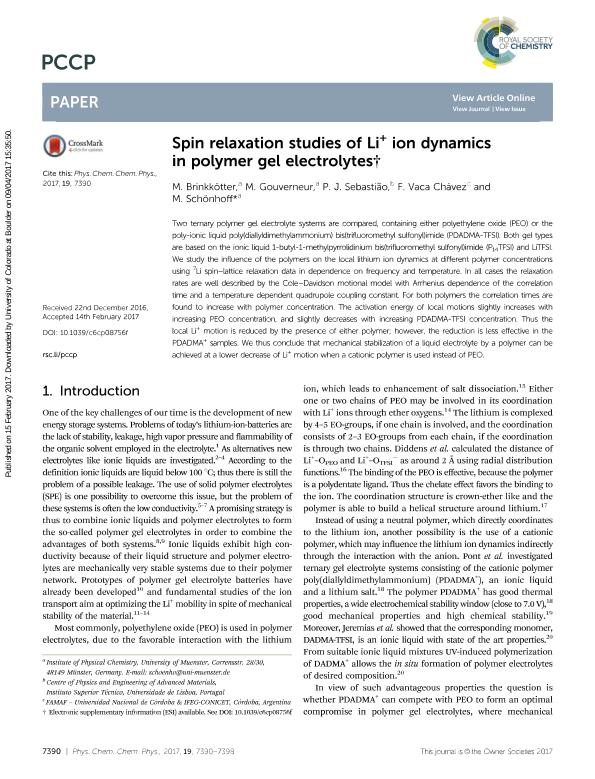Mostrar el registro sencillo del ítem
dc.contributor.author
Brinkkötter, M.
dc.contributor.author
Gouverneur, M.
dc.contributor.author
Sebastião, P. J.
dc.contributor.author
Vaca Chávez Fornasero, Fabián

dc.contributor.author
Schönhoff, M.
dc.date.available
2018-11-06T19:45:32Z
dc.date.issued
2017-02-15
dc.identifier.citation
Brinkkötter, M.; Gouverneur, M.; Sebastião, P. J.; Vaca Chávez Fornasero, Fabián; Schönhoff, M.; Spin relaxation studies of Li+ ion dynamics in polymer gel electrolytes; Royal Society of Chemistry; Physical Chemistry Chemical Physics; 19; 10; 15-2-2017; 7390-7398
dc.identifier.issn
1463-9076
dc.identifier.uri
http://hdl.handle.net/11336/63819
dc.description.abstract
Two ternary polymer gel electrolyte systems are compared, containing either polyethylene oxide (PEO) or the poly-ionic liquid poly(diallyldimethylammonium) bis(trifluoromethyl sulfonyl)imide (PDADMA-TFSI). Both gel types are based on the ionic liquid 1-butyl-1-methylpyrrolidinium bis(trifluoromethyl sulfonyl)imide (P14TFSI) and LiTFSI. We study the influence of the polymers on the local lithium ion dynamics at different polymer concentrations using 7Li spin-lattice relaxation data in dependence on frequency and temperature. In all cases the relaxation rates are well described by the Cole-Davidson motional model with Arrhenius dependence of the correlation time and a temperature dependent quadrupole coupling constant. For both polymers the correlation times are found to increase with polymer concentration. The activation energy of local motions slightly increases with increasing PEO concentration, and slightly decreases with increasing PDADMA-TFSI concentration. Thus the local Li+ motion is reduced by the presence of either polymer; however, the reduction is less effective in the PDADMA+ samples. We thus conclude that mechanical stabilization of a liquid electrolyte by a polymer can be achieved at a lower decrease of Li+ motion when a cationic polymer is used instead of PEO.
dc.format
application/pdf
dc.language.iso
eng
dc.publisher
Royal Society of Chemistry

dc.rights
info:eu-repo/semantics/openAccess
dc.rights.uri
https://creativecommons.org/licenses/by-nc-sa/2.5/ar/
dc.subject
Nmr
dc.subject
Electrolytes
dc.subject
Battery
dc.subject
Lithium
dc.subject.classification
Física Atómica, Molecular y Química

dc.subject.classification
Ciencias Físicas

dc.subject.classification
CIENCIAS NATURALES Y EXACTAS

dc.title
Spin relaxation studies of Li+ ion dynamics in polymer gel electrolytes
dc.type
info:eu-repo/semantics/article
dc.type
info:ar-repo/semantics/artículo
dc.type
info:eu-repo/semantics/publishedVersion
dc.date.updated
2018-10-22T18:18:06Z
dc.journal.volume
19
dc.journal.number
10
dc.journal.pagination
7390-7398
dc.journal.pais
Reino Unido

dc.journal.ciudad
Cambridge
dc.description.fil
Fil: Brinkkötter, M.. University of Muenster; Alemania
dc.description.fil
Fil: Gouverneur, M.. University of Muenster; Alemania
dc.description.fil
Fil: Sebastião, P. J.. Universidade de Lisboa; Portugal
dc.description.fil
Fil: Vaca Chávez Fornasero, Fabián. Consejo Nacional de Investigaciones Científicas y Técnicas. Centro Científico Tecnológico Conicet - Córdoba. Instituto de Física Enrique Gaviola. Universidad Nacional de Córdoba. Instituto de Física Enrique Gaviola; Argentina. Universidad Nacional de Córdoba. Facultad de Matemática, Astronomía y Física; Argentina
dc.description.fil
Fil: Schönhoff, M.. University of Muenster; Alemania
dc.journal.title
Physical Chemistry Chemical Physics

dc.relation.alternativeid
info:eu-repo/semantics/altIdentifier/doi/https://dx.doi.org/10.1039/C6CP08756F
dc.relation.alternativeid
info:eu-repo/semantics/altIdentifier/url/https://pubs.rsc.org/en/Content/ArticleLanding/2017/CP/C6CP08756F#!divAbstract
Archivos asociados
